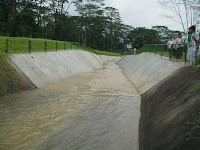The latest earthquake in New Zealand (Christchurch and surrounding area, 4 Sep 2010, 4:35a.m. Saturday, 7.1 magnitude) got me thinking about the supply of water again but this time round it prompted me to pen it down. (Long post as follows)
If you have been following this year's (2010) natural disasters - earthquakes in
Haiti,
Chile; flood in Pakistan, public water supply has always been a fragile creature. Infrastructure can be destroyed, piping and storage tanks can be broken.
In Pakistan, the deluge caused natural sources of water (e.g. wells, springs, streams) to be contaminated with whatever the flood water carried - human and animal waste, pathogens from corpses and carcasses, pesticides from farms, heavy metals from industry. In the short term though, it was the water borne diseases that caused the most problems - diarrhea, dysentry,
cholera, typhoid etc. The breakdown of sanitation and water supply led to a nightmare for public health (probably nowhere near top notch even before the flood).
Bottled water naturally became a valuable commoditity as seen in Chile when it became one of the top looted items (together with bread and candles). I imagine the same would have occurred in Haiti if there was enough bottled water to go around to be looted.
Being a developed country, New Zealand was spared from serious looting (some still took place according to the news) or outbreaks of water borne diseases. Heck, no one was killed by the quake as according to some experts, the strict building codes to quake-proof its structures have helped. (Compare against 230 000 killed in the Haiti quake.) Nevertheless, the sewage pipes were broken in the quake, allowing sewage to mix into the drinking water supply which probably probably suffered from broken piping too.
Consequently, residents in affected areas were asked to boil their tap water for drinking. I am thinking: these people are lucky (despite the quake and all). They still have electricity or/and gas. Imagine... if you have no gas, no electricity and only sewage infused tap water, how are you going to boil your water?
Imagine some more.... the NZ scenario (without the gas and electricity) happens right here in good old SG (assuming we survive the quake), do you have a wood burning stove and charcoal at home? How about a camp stove with extra gas tanks? The lucky ones will be those NOT using piped gas. The years of effort to heft around those gas cylinders would have been worth it.
Do you have Aquatabs on hand? Bleach? Do you know how much to add into water? Personally, these are not my favourite choices because of strong chlorine taste and many health controversies of overchlorination. By the way, if you opt for bleach, only use the straight ones without extra ingredients e.g. scent.
Boiling is good if you can do it but it only removes the bugs and not all the other nasty stuff (pesticides, metals) in the water. Imagine having a Pakistani scenario here. I will boil my water before running it through a good filter.
I personally recommend the British Berkefeld (or Doulton) gravity filter. (In America, it is sold under the name of Berkey.) No water pressure, no electricity needed. Simply pour your water through the top and collect clean water at the bottom. The key element in the setup is the filter candle with the ATC SuperSterasyl being the best. It has a ceramic outer shell impregnated with silver. The ceramic physically remove microbes and particulate matter from the water while the silver suppresses bacterial growth. The water next enters a granular activated carbon core containing a metal ion removal medium (works by ion exchange, I believe) to eliminate many organic compounds (e.g. pesticides), chlorine and metals (e.g. lead, cadmium).

Figure: The external setup of the British Berkefeld stainless steel gravity filter minus the faucet which should be attached near the bottom. It is certainly not small (this is already the smallest stainless steel model) so it should be used for the family or small group at a static location.
Figure: Opening the lid reveals 3 holes for fixing a filter candle each
Figure: The heart of the filter system - ATC SuperSterasyl filter candle. Notice the white ceramic exterior. Water enters through the ceramic and filtered water leaves through the black nozzle on the right.
Figure: The top portion is removable for fixing the filter candles. Filtered water goes into the bottom portion for dispensing via a faucet.
Having one of these filters will certainly add a great degree of water security to any family. And if you are involved in overseas community projects, keeping one with you serves as insurance, especially if you are not sure of the water quality or source of your drinking water.
This line of filters may be procured locally from
Arkwater. Of course, I am in no way affiliated with the company except for purchasing these filters from them.





































.JPG)





